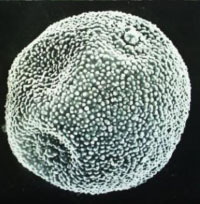Nettle family
Latin name: Urticaceae (family)

Plant description: There are several members of this family but the two that are most important to allergy sufferers are common nettles (Urtica dioica) and pellitory-of-the-wall (Parietaria judaica). They have very similar pollen borne on tiny flowers which are greenish in nettle and reddish/white in pellitory-of-the-wall.
Distribution: Pellitory-of-the-wall: In the UK, S. & E. England, Midlands, coastal Wales, very local in N. England, rare in Scotland, also found in Ireland. Grows in crevices of old walls. Nettles: Widespread. Rest of world: nettles are cosmopolitan in temperate climates, Pellitory of the wall is widespread in much of C. & S. Europe (particularly the Mediterranean) and the Americas.
Allergenicity and other health impacts: Generally moderate allergenicity in the UK. The nettle family are classed as ‘Weed pollen’ for forecasting purposes. It is not known exactly how many people in the UK are affected by nettle pollen as very little work has been done on this topic. However, a study conducted in Southampton[1] found that out of 62 patients that were skin-prick tested for sensitivity to a range of allergens, 13 were sensitive to nettle and 8 to pellitory-of-the-wall.
Season: June to early September, with peaks in late June/early July and again in mid-August. There tends to be a daily peak around 6pm in the evening on high count days[2]. Nettle pollen is released in the highest quantities on warm, dry days with a gentle breeze.